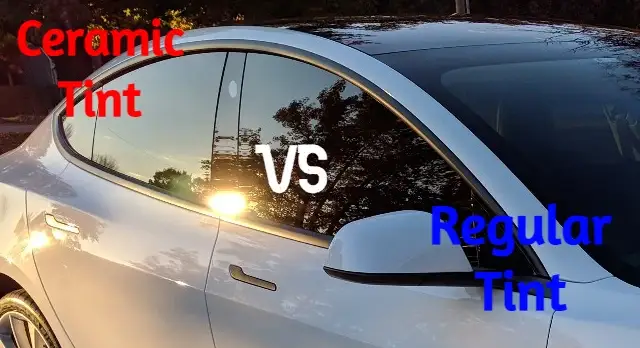When it comes to tinting your windows, you have a variety of options to choose from. Among them, ceramic tint and regular tint are two popular choices. Each type offers its own set of advantages and considerations. In this article, we will explore the differences between ceramic tint and regular tint, helping you make an informed decision about which one is best suited for your needs. Let’s dive in!

Understanding Ceramic Tint and Regular Tint
Before delving into the comparison, let’s briefly understand what ceramic tint and regular tint are:
Ceramic Tint: Ceramic tint is a type of window film that contains ceramic particles. These particles are non-metallic and non-conductive, offering excellent heat and UV rejection properties. Ceramic tint is known for its high clarity and superior heat reduction capabilities, making it a popular choice for those seeking enhanced comfort and protection.
Regular Tint: Regular tint, also known as dyed tint, is a window film that uses a dye layer to absorb and reduce the amount of light entering the vehicle or building. This type of tint provides basic heat and UV protection and is often more affordable compared to other options. Regular tint is commonly chosen for its privacy benefits and aesthetic appeal.
Comparison: Ceramic Tint vs Regular Tint
To help you understand the differences between ceramic tint and regular tint, let’s compare them across various factors:
| Factors | Ceramic Tint | Regular Tint |
| Heat Reduction | Excellent heat rejection properties | Moderate heat reduction |
| UV Protection | High level of UV ray blocking | Basic UV protection |
| Clarity | High clarity, minimal interference with visibility | Slight color distortion may occur |
| Fade Resistance | Highly resistant to fading and discoloration | May fade over time |
| Signal Interfer | Non-metallic, does not interfere with electronic signals | May interfere with GPS, cell reception, etc. |
| Cost | igher cost compared to regular tint | More affordable option |
| Aesthetics | Subtle and sleek appearance | Wide range of colors and shades available |
Which One Should You Choose?
Choosing between ceramic tint and regular tint depends on your priorities and budget. Here are some scenarios where each type of tint may be more suitable:
Ceramic Tint: If you prioritize heat reduction, UV protection, and high clarity, ceramic tint is an excellent choice. It offers superior performance and durability, making it ideal for those who spend a significant amount of time in their vehicles or desire top-of-the-line window tinting solutions.
Regular Tint: If you are on a tighter budget or primarily seeking privacy and basic heat reduction, regular tint can be a suitable option. It provides a range of color choices and offers a cost-effective solution for those who want a tinted appearance and some level of protection.
Key Takeaways
- Ceramic tint offers excellent heat reduction, high UV protection, and superior clarity, making it ideal for those seeking top performance and durability.
- Regular tint provides basic heat reduction, privacy, and a variety of color options at a more affordable price point.
- Consider your priorities, budget, and desired benefits when choosing between ceramic tint and regular tint.
In conclusion, both ceramic tint and regular tint have their advantages and considerations. Assess your needs, budget, and preferences to make an informed decision. Whether you prioritize exceptional heat reduction and UV protection with ceramic tint or seek an affordable tinting solution with regular tint, professional installation and proper maintenance are crucial to ensure the longevity and
FAQs
What is the main difference between ceramic tint and regular tint?
The main difference lies in the composition and performance. Ceramic tint contains ceramic particles that provide superior heat reduction and UV protection while maintaining high clarity. Regular tint, on the other hand, uses a dye layer for basic heat reduction and privacy benefits at a more affordable price.
How does regular tint compare to ceramic tint in terms of fading?
Ceramic tint is highly resistant to fading and discoloration over time, ensuring long-lasting performance. Regular tint may experience some fading and discoloration, especially if exposed to prolonged sunlight.
Is ceramic tint better than regular tint?
Whether ceramic tint is better than regular tint depends on your specific needs and preferences. Ceramic tint offers superior heat reduction, high UV protection, and excellent clarity. It is known for its durability and long-lasting performance. On the other hand, regular tint provides basic heat reduction, privacy benefits, and a variety of color options at a more affordable price. Consider factors such as heat reduction, UV protection, clarity, and budget to determine which type of tint is better suited for your requirements.
Does ceramic tint look darker than regular tint?
The darkness of tint is not necessarily determined by whether it is ceramic or regular. Tint darkness is usually measured by its Visible Light Transmission (VLT) percentage, which indicates the amount of light that can pass through the tinted window. Both ceramic tint and regular tint are available in various VLT percentages, allowing you to choose the desired level of darkness. So, the darkness of the tint is a separate consideration and can be adjusted according to your preferences and local regulations, regardless of whether it is ceramic or regular tint.
